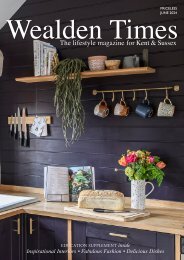Wealden Times | WT260 | January 2024 | Good Living Supplement inside
The lifestyle magazine for Kent & Sussex - Inspirational Interiors, Fabulous Fashion, Delicious Dishes
The lifestyle magazine for Kent & Sussex - Inspirational Interiors, Fabulous Fashion, Delicious Dishes
You also want an ePaper? Increase the reach of your titles
YUMPU automatically turns print PDFs into web optimized ePapers that Google loves.
Anemone blanda<br />
know where the scent is coming from.<br />
Sarcococca confusa (Christmas box) is<br />
a small, low growing evergreen, often<br />
overlooked, but it pumps out an almost<br />
overwhelming perfume. Two larger<br />
shrubs that are straggly nothings in<br />
summer, but hard to be without at this<br />
time of the year, are the wintersweet<br />
– Chimonanthes praecox and Lonicera<br />
‘Winter Beauty’, a winter flowering<br />
honeysuckle. Plant them where they<br />
can fade into the background once<br />
the flowers are over, but near enough<br />
for you to catch the fragrance.<br />
Many of these late winter and early<br />
spring performers are suitable for<br />
growing in containers too, in fact<br />
something like a camellia may even<br />
prefer it, as these need acid soil.<br />
The great thing about a plant in a<br />
pot is that it can be moved away<br />
from centre stage once it’s done its<br />
thing – if you can move it, that is.<br />
Magic Wands<br />
The young stems of dogwoods (Cornus)<br />
will provide brilliant winter colour,<br />
especially if you are able to plant several<br />
together. Dogwoods will grow in most<br />
soil conditions, and they actually quite<br />
like damp or heavy soils. They don’t<br />
mind shady conditions, but their stem<br />
colour shows up best in full sun. They<br />
will send out suckers, so plant them<br />
where they have room to spread. The<br />
stems also look good cut and poked into<br />
winter containers, bringing height and<br />
structure – they may even take root.<br />
For the best stem colour, Dogwoods<br />
should be cut back hard in spring to<br />
encourage the growth of new young<br />
stems which have the strongest colour.<br />
Some will cope with hard pruning<br />
better than others – generally the more<br />
vigorous the growth, the harder you can<br />
cut back. After pruning, mulch around<br />
the roots with compost or other wellrotted<br />
organic material, but not right up<br />
to the stems, as this could cause them to<br />
rot. Mulching will feed and condition<br />
the soil – and also help retain moisture.<br />
Dogwoods won’t get too tall, because<br />
they are regularly pruned to the base.<br />
Some of the best for stem colour are:<br />
Cornus alba ‘Sibirica’, which has bright<br />
red new growth, while the aptly named<br />
C. sanguinea ‘Midwinter Fire’ has young<br />
stems that literally look as if they’re<br />
on fire – in shades of yellow/orange<br />
tinged with red. Cornus stolonifera<br />
‘Flaviramea’ has yellow-green stems;<br />
Cornus alba ‘Kesselringii’ has young<br />
growth of a deep purple colour.<br />
Willows can (literally) run about in<br />
the garden, so should be carefully<br />
positioned, as they can be invasive and<br />
hard to remove. They are fast growing<br />
and some have brightly coloured<br />
stems to rival the dogwoods. Salix<br />
‘Britzensis’ is one of the best for stem<br />
colour, but will need regular pruning.<br />
Just like Cornus, willows are best<br />
grown near water or in boggy places.<br />
Jewelled Carpets<br />
Bare stems and branches are<br />
companionably set off with contrasting<br />
carpets of snowdrops – the earliest of the<br />
bulbs to flower. These tough little plants<br />
will push up through snow (hence the<br />
name) and frozen ground and naturalise<br />
quickly in places where not much else<br />
dares to grow – in the shade and among<br />
the roots of trees. Slightly later, but<br />
still early, Cyclamen coum, Anemone<br />
blanda, and bulbs like winter aconite<br />
and crocus will emerge. These little<br />
treasures are best seen in massed throngs<br />
beneath the trees, where they make<br />
the most of the light before the dense<br />
canopy of leaves closes in on them.<br />
Hellebores are good and hardy, often<br />
flowering where not much else will<br />
and are a great asset in the garden<br />
at this time of the year. Helleborus<br />
niger (the Christmas rose) flowers in<br />
winter, these are usually white, but<br />
Helleborus orientalis cultivars flower<br />
later, most often in pink shades from<br />
pale to the darkest burgundy.<br />
Low growing evergreens look good<br />
next to bare stems, even low growing<br />
dwarf conifers, or hardy ferns such<br />
as Polystichums will work well and<br />
bring all year foliage interest.<br />
Structure is vital in the garden, perhaps<br />
even more so in winter when we<br />
can’t distract ourselves with flowers<br />
and foliage. We need architecture,<br />
focal points and framework plants.<br />
Right now evergreens, or those with<br />
elegant skeletons, striking bark, or<br />
uplifting fragrance – plants that<br />
might be overlooked during the rest<br />
of the year, shine out beautifully.<br />
Jo’s gardening courses starting<br />
in spring are now booking<br />
07923 969634 hornbrookmanor.co.uk<br />
97<br />
priceless-magazines.com


















